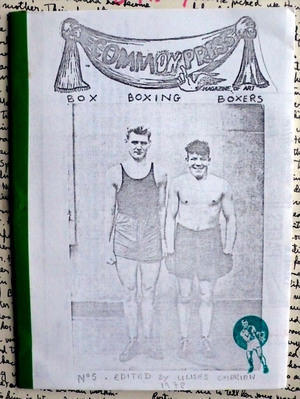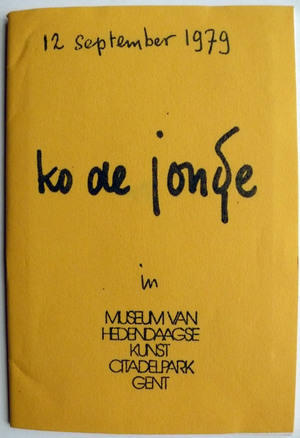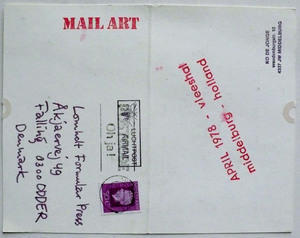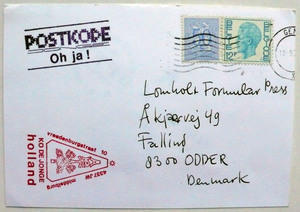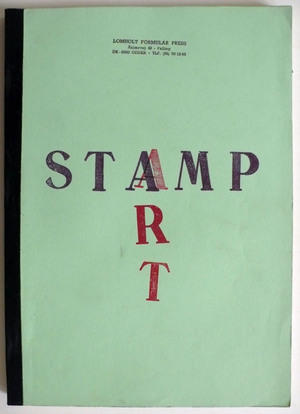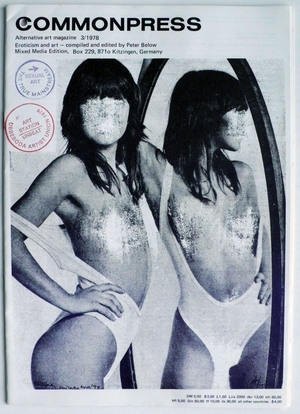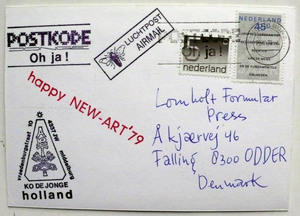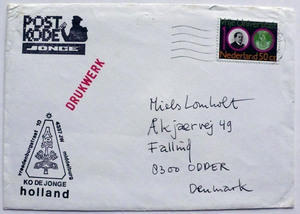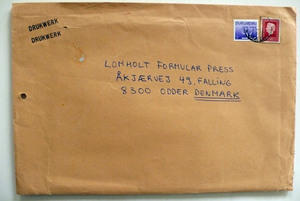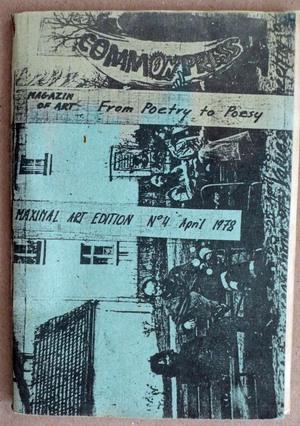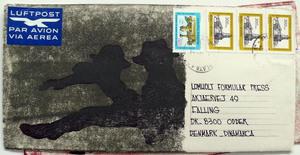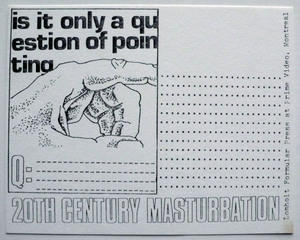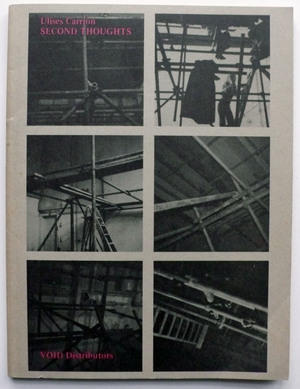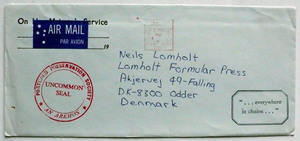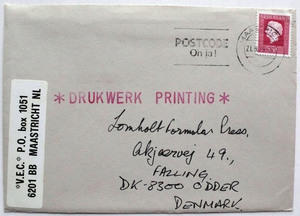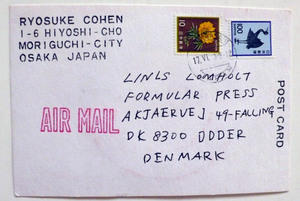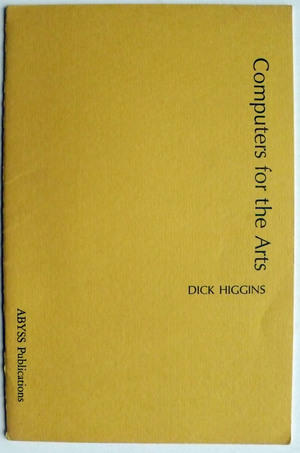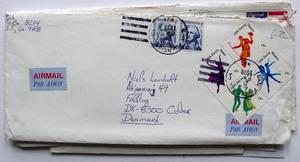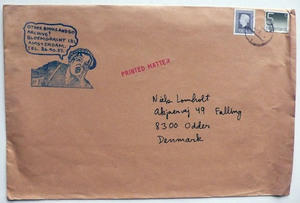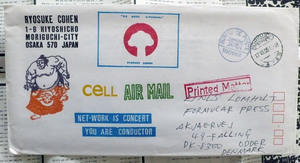BOX BOXING BOXERS.
Mail Art Projects, Exhibitions and Archives
By Peter van der Meijden
”Box boxing boxers” was the title of the fifth issue of the magazine Commonpress, edited in Holland by Ulises Carrión in 1978. Carrión chose it because of the many connotations of the words, from containers to contact sport, and it is appropriated in the context of this article for broadly the same reason. This article deals with mail art, exhibitions and archives, so the word “box” can be taken to stand for the exhibition space, the archive box or the art historical “boxes” (frameworks), mail art can be put into, as the situation demands and as the reader chooses. Above all else, however, “box boxing boxers” is understood as a pharmakon, a cure that is a medicine and a poison at the same time and hence something that always and necessarily has multiple meanings. This type of cure and the (in)stability of meaning in general are the subject of the second section of this article, which deals with mail art exhibitions and exhibitions in general. Here, the cure teams up with the curator as an art professional and curating as an artistic strategy. The third and final part of the article elaborates upon curing as a method of preservation. It concentrates on archives and the act of saving, both in the sense of “saving from oblivion” and “putting money in the bank”, but it also looks at the various uses an exhibition and an archive can be put to, from the control of meaning to the openness of the “scenario” as a way to communicate knowledge.
The driving force behind the article is curiosity – curiosity about the reason why Mail artists, despite their vociferous criticism of the “official” art world, nevertheless chose to organize so many exhibitions, print so many catalogues and found so many archives. However, it is also an introduction to the Lomholt Mail Art Archive. Because of the size of the archive, choices had to be made. First of all, the article focuses almost exclusively on mail art projects, even though these only account for a fraction of the entire mail art output. Moreover, the focus is on Holland; not only am I a Dutchman myself, but Holland was also an important center of mail art activity, worthy of special attention. The choice for Holland was made in full awareness of the fact that mail art was a truly global phenomenon and that a national or regional focus can therefore easily be misleading. Finally, most of the primary material is taken from the archive, although there are many more and sometimes better examples out there. I hope the reader will bear with me on this.
That said, it is time for round one: box boxing boxers, with special attention for the intermedial character of mail art.
1. Box Boxing Boxers
The fifth issue of the magazine Commonpress, edited in 1978 in Holland by Mexican artist Ulises Carrion (1941-1989), was called “Box Boxing Boxers”. The title was the theme of the issue, and the editor had been free to determine it by himself. The idea on which Commonpress was based, was simple, but revolutionary. The first issue had been issued by Pawel Petasz, a Polish mail artist (1951), in December 1977. Petasz’ idea was that one of the contributors to any particular issue would agree to publish the next, thus turning publishing into a kind of relay race (although Petasz provided continuity in his role of general editor). The idea had enormous implications. For one thing, it was supportive of do-it-yourself publishing. It meant that consecutive people would make the effort and carry the cost of editing and printing the magazine. More importantly, however, it broke down the differences between the roles of contributor and editor. This is not the same as saying that it was anti-professional. If professionalism needs to be mentioned at all, then what we are dealing with here is a new professionalism, a heteroprofessionalism or perhaps an interprofessionalism. It is a kind of professionalism where creative activity and editing seamlessly merge. While many, and perhaps even most, “little” magazines, or ‘zines, can be said to be artworks in themselves, integral parts of the artist/editor’s production, Commonpress was different in one important aspect: diversity was its single most defining characteristic. True, each issue bore the stamp of a particular artist/editor, but what is much more important is that as a publication, it bore the stamp of a different artist/editor every time.
Petasz’ own first issue was later characterised quite straightforwardly as a “mail art sampler”. The second issue, however, edited by Dutch mail artist Ko de Jonge (1945), invited contributors to reflect on the difference between “open” and “closed”. As will be shown further on, the question was directly linked with De Jonge’s own artistic practice. The third issue, edited by Peter Below (1949) in the Federal Republic of Germany, also picked up on the artist/editor’s own interest, in this case eroticism. The fourth issue, edited in Poland by Grzegorz Dziamski (1955), had “From Poetry to Poesy” as its theme. And then, in spring or early summer 1978, came no. 5, on “Box Boxing Boxers”. Perhaps the editor had a special interest in boxes or boxing, but if he had, it played no role. Carrion explained his choice of theme by means of a short text in which he set his readers a puzzle: “The question now arises: has this anthology primarily to do with art? Or has it to do with box?”, he asked, adding that “this question is valid, regardless of the plurality of meanings of the word ‘box’, which lead some participants to take it as meaning ‘sport’ and some others as ‘receptacle’.” As usual, Carrion cut right to the heart of the matter. Yes, the words “box”, “boxing” and “boxer” can be understood in various ways and were understood in various ways by the contributors to the issue. But was that the point? Was the theme the point? Or should the reader be pondering the artistic implications of the entire exercise instead?
In an article called “Mail Art and the Big Monster” (1977), Carrion engages in a little light meditation on the words “mail” and “art” and their coupling in mail art as a genre. About art, he just wrote: “art is for art, for art and absolutely nothing else”. Not a definition as such, but at least a formulation of the drive behind the phenomenon: art is motivated only by art. The postal system, however, is motivated by quite different interests, interests quite exterior to art. It is the postal system that is the “Big Monster” from the title; perhaps it can be loosely translated as “the state bureaucracy”. Etymologically speaking, the word “monster” derives from the Latin monstrum, an abnormal being. Monsters show that something is wrong within the natural order. Presumably, Carrion regarded the state bureaucracy as showing exactly that. In any case, he argued that artists can neither manipulate nor be held responsible for the postal system; they can only use it. Mail art, then, can do two things: it can use the mail as if it was a mere carrier, a “canvas” in Carrion’s words, or it can use it as a medium. In the first case, the postal system is used only to transport art from A to B, while in the second, it becomes part of the artistic strategy. The art medium and the postal system merge. This happens when “an artist conceives of a piece in which mailing, the act of using the post office, postage stamps, one or several post office clerks or any other element of the postal system play an important role”.
In saying so, Carrion understands mail art broadly along the same lines as Dick Higgins (1938-1998), the American multi-artist who is best known for his deep involvement in Fluxus, but who also was an active member of the mail art community. It pays to look at Higgins’ definition of mail art in order to clarify Carrion’s argument. The background for Higgins’ understanding of the word is the term “intermedia”, which the artist coined in 1966 to characterise a whole host of artistic phenomena that could not be reduced to a single medium. About mail art, he said: “If we take an art as a medium and the postal system as a medium, then mail art is the intermedium between these – postal poetry, postal music, mail art [visual variety], etc.”1 Unlike Carrion, Higgins does not regard mail art as a wedding of just two media, art and the postal system, but many possible weddings of different media with the postal system. The intermedium of poetry and the postal system, music and the postal system, visual art and the postal system – all these are mail art.
There are a few things that it is important to note about intermedia as Higgins understands it. Firstly, intermedia is not the same as multimedia, because multimedia employs different media that can still be recognised as such, while intermedia blurs the boundaries to such a degree that it no longer makes sense to speak of distinct media. Secondly, Higgins spoke both of art media and of “life media”, so the word “media” in intermedia covers much more than art alone. The example he used in the article from 1966 in which he first launched the term2 was shoes, but in the case of mail art, it is the postal system. Finally, intermedia works are according to Higgins never determined by pre-existing rules. Each work, he says, determines its own medium and rules according to its needs. Like Carrion, he put art first. Art defines the need, and the need defines the medium and the rules that apply. A work of mail art, then, will not follow the rules of poetry, music or the visual arts, of the postal system or even of both media at the same time, but will define its own.
Returning to Carrion’s theme for Commonpress no. 5, the question of whether it is about art or about the words “box”, “boxing” and “boxers” can now be seen to be much more complex than it appears. It can be safely assumed that Carrion interpreted the theme as an invitation to send works of mail art, so the intermediality of the material as a hybrid between the art medium and the life medium of the postal system, is a given. This means that the words are not the second, but the third component (the first two being art and the mail). Commonpress 5, like so much mail art, sought to combine three different actions, creation (art), communication (mail) and reflection (the theme). When Carrion asks what it is about, the art or the theme, he implicitly points to the interrelatedness of all three components. He does not spell it out, but leaves it to the reader him/herself to work it out. How do art and the postal system come together to define the words “box”, “boxing” and “boxers”? How does the postal system get the various definitions to come together in a more broadly significant context? How is the art informed by the postal system and the words? One can keep on rephrasing the question, but every version of it will point to the same two things. Firstly, they all show how inextricably interrelated the three components are and therewith confront the reader with the essential intermediality of the project. Secondly, they all point to the necessity of the reader to actively involve him-/herself. Entirely in accord with Higgins’ definition of the intermedium, no outside rules apply. The project dictates the rules, so the reader can never be prepared and has to work out what they are in the process.
2. Cure Curing Curators
Today, the task of working out which particular kind of intermedium we are faced with and that of determining the rules the work sets for itself, has become even more complicated. If Carrion’s boxes were suggestive of letterboxes and parcel post back in 1978, they are now equally, or perhaps even more, suggestive of the cardboard boxes that most mail artists seem to keep their archives in and the archive boxes that contain those few mail art collections that have made it to the museum. The archive and the museum operate according to their own rules; rules which, unlike those that govern the intermedial work of art, are known beforehand (although this, as will be shown in the third section of this text, is a problematic statement). Archives and exhibitions of mail art further complicate the already complicated task that mail art sets the spectator. Where he or she initially only had to work out the way in which the works functioned – and this is in itself a very big “only” – he or she now has to work out how to combine the implicit rules of the work with the explicit rules of the archive and the museum as well. And there is a third complication lurking just around the corner. In a more metaphoric way, Carrion’s boxes now also point to the “boxes” that academic discourse and the curated exhibition force mail art into.
A recent exhibition called Arte Postale: Bilderbriefe, Künstlerpostkarte, Mail Art at the Akademie der Künste in Berlin (30 August-8 December 2013) is an excellent example. For one thing, it combined the archive and the exhibition in its very fabric: the mail art section opened with a display of the archive boxes that normally contain the mail art collection of Chilean artist Guillermo Deisler (1940-1995). Both as archive boxes and as a curatorial trick, they add meaning to the projects and contributions contained in them. They complicate them. As archive boxes, they add the idea of objectivity and historicity, of a knowable past. As a curatorial trick they suggest that here, in these privileged spaces, that past will unfold itself in front of our very eyes. But the mail art works on display were also “boxed” in an art historical way. The show performed two apparently contrary actions. On the one hand, it made a selection. In the mail art section, special attention was given to the postcards published by German mail artist, designer, publisher and activist Klaus Staeck (b. 1938), which drew the attention away from the unique works that circulated in the mail art network and towards the printed material. On the other hand, mail art was connected to an older tradition of illustrated letters by artists. The one movement implies a restriction, the other an expansion.
This is no criticism. It is merely a way of illustrating the problem in hand and, more specifically, a way of illustrating the different rules that come into play. Exhibitions are expected to have a clear focus: one of the things a curator is supposed to do is to select the material on behalf of their audience. The special attention given to postcards is only a sign of professionalism on the part of the curator. And on the other hand, exhibitions are expected to present a coherent whole. There has to be a bigger story in them, whether stylistic, chronological, thematic or otherwise. Once again, in opening the vista back towards the illustrated letter, the exhibition proved itself to be a professional affair. The snag is that the professionalism of the archivist, the librarian, the (art) historian and the curator is a different one from the one that is called for by the works and the projects.
Many mail artists are skeptical about these other professionalisms and what they can contribute. Dick Higgins says:
“In shows, the work is arranged not by conversation but according to a curator’s skills of the past, as if these were drawings by Goya. But they aren’t. Their meaning is more private, often contained in the facts and conditions of their existence more than in the art traditions to which they seem to belong. (…) I have probably seen forty or fifty actual exhibitions of mail art, and NOT ONE OF THEM was interesting to see. There were good things in each of them of course, but the effect of looking at them was weak. Why? Because they did not reflect the function – they always treated the sendings as final artifacts (…). But mail art pieces are virtually never artifacts – they are conveyors of a process of rethinking, community-building and psychological and intellectual extension”. 3
Higgins characterises the professional skills of the curator – and we can safely add the archivist – as “skills of the past”. These skills were brilliantly summarized – and caricatured – by East German mail artist Joseph W. Huber (1951-2002) when he subtitled an old lithograph of a scholar in a library “At the Mail Art Archive – The Importance of Mail Art in the History of Art”. The message is clear: the art historian puts works in neat rows for comparison and incorporation in a larger, artificially created whole. To the art historian, each work is similar to the next. They have to be, because otherwise they cannot be shelved, taken out when needed and, the aspect that is most important for the present argument, related to other works in a way that strikes the art historian as worthwhile.
The alternative, which Higgins does not explicitly describe but which is nevertheless very present in his text, must be “skills of the present”. These would have to do with the work’s existence rather than its role in art history; with the way it works instead of the way it looks; with the responses it solicits rather than its physical form. However, it is not a simple opposition between “then” and “now” that Higgins is after. In another passage he says: “But a show arranged chronologically of the exchanges among some specific circle of mail artists – that would have a greater chance for an outsider to learn the language and love the medium”. Higgins does not want the curator and the archivist to focus on the present as a simple “now”, but on the “liveness” of the art; on the effect one person’s thoughts have on another person’s thoughts and on the effect one work has on other works. The professionalism needed, he says, is the ability to see and show the connections between things, rather than the things themselves as points that draw a larger picture. Implicitly, this is also what Carrion invites the readers of Commonpress no. 5 to do: to spot the connections between the individual contributions, to create a mental map of all the different views that are in evidence and to speculate about their connectedness – via art, via the postal system and via his theme of the box, boxing and boxers.
It is not difficult to see why someone like Higgins should think that traditional museum displays of mail art are problematic. What, after all, is a museum display? What is an exhibition? Swiss art historian Hubert Locher defines it as an “arrangement, usually of several selected objects, in a more or less publicly accessible space”.4 Although short, the definition is extremely useful, identifying, as it does, most of the key elements of an exhibition. For a start, it is arranged. Objects are not placed higgledy-piggledy in the room but are carefully placed in relation to each other. Secondly, the objects are selected. Certainly, some exhibitions simply show all that there is, but most often, they will only present a portion of the available material, and a portion that is selected to illustrate a particular point. And finally, the objects are selected and arranged with an audience in mind. What we are faced with in a museum display or exhibition is not the contents of the vaults of a museum or library, its layout only designed to suit a few members of staff, but an ensemble that is designed for ready consumption by an audience. What Higgins was worried about, was exactly that: that exhibitions changed the living exchange between artists into a carefully mapped history, using individual words as signs that spell out a narrative.
As pointed out at the start of this text, the mail art network generated a great many exhibitions as well. The first question to ask, then, is whether mail art exhibitions curated by the artists themselves follow the same pattern. In many texts on mail art, the exhibition Omaha Flow Systems at the Joslyn Art Museum in Omaha, Nebraska, on 1-24 April 1973, is offered as a model. What is particularly noteworthy about this exhibition is that it existed on two levels. On one level, it was a system – a “flow system” developed as an artwork by American artist Ken Friedman (1949), like Higgins a prominent Fluxus associate. On another level, it was a presentation of thousands upon thousands of artworks and other communications that flowed into Omaha by mail. An announcement describes the event as “both a massive interchange of ideas and a scope of multi-level communication that has seldom if ever been encountered in man’s history”. At its basis lay a mail art call, an invitation to five thousand (!) people around the world to send their work to Omaha. The works received were put on display, perhaps at the museum, perhaps at one of the “orbital Flow Systems locations”. These could be another gallery, but they could equally well be a university, a college or even a shopping mall. Of course not everybody responded, but those who did often sent more than one work, so there were thousands of works in the show, and perhaps tens of thousands. Friedman first spoke of 4.000 works, but later corrected it to 20.000. The uncertainty is partly caused by an extra rule added by the artist: visitors were allowed to take a work back home with them under the condition that they left something of their own and wrote their opinion to the artist. All this had to be logged, but the high number of visitors towards the end of the show, combined with a large number of artworks arriving late, made this impossible to do.
A short description like this does not do justice to the size and complexity of a project like Omaha Flow Systems. The exhibition was accompanied by dozens of events that added to the flow, discussions, performances, activities for children and much more.5 What is important to note here is that we are not just faced with an intermedial work of art, but with a “meta”-intermedial one. The material component of the work consisted of mail art, as an intermedium of art and the postal system, but the exhibition was itself an intermedium of the mail art-intermedium and the “life” medium of the exhibition. Omaha Flow Systems was not only a mail art show, but a show-as-artwork as well, and what made it so is the fact that Friedman challenged and displaced the basic characteristics of the exhibition as an integral part of the concept. The first ingredient of Locher’s definition is the fact that exhibitions are arranged. In the case of Omaha Flow Systems, however, the rule that people could swap a work for something of their own meant that you could never be sure whether a particular arrangement of objects was intentional or accidental. The uncertainty was a part of the very fabric of the idea, and therewith of Friedman’s concept (work). The second characteristic mentioned in Locher’s definition is selection. Once again, Omaha Flow Systems subverts the rule, because the only form of selection that was applied, took place after the exhibition had been installed and was carried out by the individual visitor. As a point of departure, every single contribution was put on display and every contribution that entered the show as a result of a swap by a visitor, was accepted. Once again, the displacement of the selection process was a part of the idea. Finally, Locher points out that exhibitions are organised on behalf of the audience – a passive audience, that is, which stands at the receiving end of the curator’s involvement. Omaha Flow Systems turns this rule on its head by making the audience the prime selecting agent. In effect, Friedman defined his exhibition concept in such a way, that the exhibition began to function like the mail art network, or at least like Higgins wanted it to function: part of the concept was the invitation to the audience to respond to the works that had been sent in by mail artists who in their turn responded to a mail art call sent out into the network by Friedman. Repeating Higgins’ words, the exhibition visualised “a process of rethinking, community-building and psychological and intellectual extension” – extension, that is, of other people’s thoughts and actions.
Friedman’s call was not themed, like Carrion’s invitation to respond to the words “box”, “boxing” and “boxers”. If there was a theme at all, it was the exhibition itself. This special circumstance gives cause to take a closer look at the second of Locher’s three key words, “selection”. Another definition of the exhibition, this time by American poet, translator and literary scholar Susan Stewart, helps to clarify this particular aspect. The aim of an exhibition, Stewart writes, is “not the restoration of a context of origin, but rather the creation of a new context, a context standing in a metaphorical rather than contiguous, relation to the world of everyday life”.6 Things are taken from a particular situation and inserted in a new one, artificially created to represent the original one. What is more, the new context represents something artificial, an idea. The most obvious example of this is the ethnographical display, in which single items – pottery, masks, hunting implements, you name it – are chosen, selected, to represent an entire culture. They once had a vital role to play, but now they are locked away in display cases in museums as illustrations of an idea of a culture that they used to be a part of.
One can hardly treat items of mail art as ethnographic artefacts. After all, mail art existed (exists) firmly within Western culture, even if it goes against the grain. Nevertheless, one of the things Higgins objects to in curated exhibitions of mail art is that the works are taken out of some kind of vital context and isolated. The idea is beautifully illustrated by Dutch mail artist Ko de Jonge’s contribution to Carrión’s issue of Commonpress. De Jonge (1945) sent in a work consisting of four fields, the outer two of which depict a sign and the middle ones a box. On the left hand side, the sign reads “open”, on the right hand side, “closed”. The signs are repeated underneath the boxes in the middle: the one on the left, showing a key hanging inside, is accompanied by a sign saying “closed” and the one on the right, without the key and with an open door, by a sign saying “open”. Underneath the four fields is the caption: “The Quintessence of an Exhibition – The Action of Three Objects”. The door is open, the caged bird has flown out. Art is set free, no longer isolated but able to interact freely with all the other elements that make up our living environment.
This is entirely in accord with Higgins’ image of mail art and mail art exhibitions, but is it really that simple? Ponder it just a little bit more and it manifests itself as an instance of the age-old puzzle about how to open a treasure chest with a key that is locked inside it - and the ambiguities only grow from there. For instance, which “action” of which three objects does the artist mean? After all, there are four fields and two states (open and closed). The two states affect four elements (sign, box, door and key), so in all there are sixteen (24) possible constellations. No threes come into it at all. Or do they? One possible answer lies with the word “action”. When reading the work through the objects depicted, we treat it like a museum display, now understood the way Stewart presents it, as an artificial context in which the objects act out their metaphorical relation to the outside world. “Metaphorical” can here be taken quite literally, as in the Greek verb meta-pherein: to transport. Something is literally transported from one context to another. As a figure of speech, a metaphor describes something by suggesting that it is, on some point of comparison, the same as another otherwise unrelated object. All four objects in De Jonge’s work can be seen as metaphors. If one takes the actions that are implied in them as one’s point of departure, however, the image that emerges is a rather different one. You take the key (possibly by means of a feat of magic), you open the box, you turn the sign from “closed” to “open”. You find the solution, you apply it, you announce it to the rest of the world: three actions. This alternative reading no longer produces a metaphor, but a metonymy. Turning to the ancient Greeks once more, what happens is a meta-noumia, a change of name. A metonymy is a figure of speech in which something is called not by its own name but by the name of something associated in meaning. There is no change of context. The thing and the name it is called by, belong to the same context. The connection between thing and context is not severed, as would be the case in a metaphor, but merely placed in another light. In this particular case, it is problem-solving that is the key word. You could read the box as the museum, the key as part-artwork, part-solution and the sign as the public announcement of the solution, but then there would only be one possible answer. This is the metaphorical reading. In the metonymical reading, the action would come first and the objects could be replaced with any others to which the action applies.
To further explore the point, another work by De Jonge involving keys can be drawn into the discussion. In 1978, he realised a work by Argentinian poet/mail artist Edgardo Antonio Vigo (1928-1997) from 1969, entitled Obras (in)completes, “(In)Complete Works”. The work consists of four labels bearing the name of the artist, the title of the work and a tome number, 1-4. The accompanying text instructed the recipient to fix the labels to four objects, which would then be turned into a work of art. In Vigo’s own words, “a certain percentage of the creation is transferred to wherever you decide to place them”. The (in)complete works must here be taken to be “the creation”; affixing the labels to four objects means transferring a percentage of the complete work to the object. Once again, we are dealing with an extremely paradoxical work. For one thing, the (in)complete work cannot be genuinely said to be Vigo’s if the objects are designated by others. And for another, choosing objects to be part of the work lowers the art content of all the other objects: each object acquires an art value equal to a percentage of the work, so the more works, the smaller a percentage of the total work they represent. Vigo, therefore, turns the Duchampian readymade on its head in several respects. If Duchamp turned everyday objects into works of art by signing them himself, Vigo does so by proxy, by getting others to pick the objects, and if Duchamp gave ordinary objects extra value by means of his signature, Vigo brings devaluation into the equation by creating a work that can be diluted.
Of course De Jonge attached keys to the labels – but he did more. If he had stuck to the keys, his contribution might arguably have addressed the question of a “closed” art world and the desirability of its opening once again. However, he also wrote, “Ko de Jonge 1979” underneath, marking the 10 year anniversary of the work. Here, it is important to note that the work was produced in 1978, so the year 1979 is not just a date. The round time span implies a different sort of closure, perhaps the end of a period, perhaps even the end of a life. The latter was also implied by Vigo himself, who printed a small cross on the label, similar to the one used to mark dates of death. To a recipient at the time, the connection with death would have been even more obvious. Everyone would have been aware of the dirty war that the Argentinian junta at the time waged against everyone who was suspected of standing to the left of the center. In fact, Vigo’s own son, Abel Luis, “disappeared” on 30 July 1976 at the age of 20. Many mail artists would have received Vigo Sr.’s stamp showing Abel Luis’ portrait, accompanied by the text “Set Free Paloma 30/7/76” in the post (“Paloma” was his son’s nickname). By means of two simple interventions, the addition of a key and of a date, De Jonge turns Vigo’s already multilayered work into something even more ambiguous and poly-interpretable.
Comparing Vigo’s (In)Complete Works and his Paloma-stamp, one cannot help but notice the the huge difference between the two: in De Jonge’s terms, the former appears “open” and the latter “closed”. True, they both invite the reader/spectator to involve him-/herself actively, but in the case of the (In)Complete Works, this consists in a mental effort, while the stamp calls for activism. The same thing goes for exhibitions. A good example is a mail art exhibition in Dubbo, Australia, on 10-15 November 1980. During those six days, the inhabitants of Dubbo – it is hard to imagine many people driving up there especially to see the show, as the nearest large city, Sydney, is 400 km away – could inspect some 1.000 items of mail art, not at a museum, but at a shopping centre called Orana Mall. At least in this respect, the exhibition resembled Omaha Flow Systems. Unlike Friedman’s exhibition, however, but like many other mail art shows, it had a theme. In this particular case, the theme was “…everywhere in chains…”, a quote from Book I, Chapter 1 of the French philosopher Jean-Jacques Rousseau’s Of The Social Contract, Or Principles of Political Right (“Du contrat social ou Principes du droit politique”, 1762): “Man was born free, and he is everywhere in chains”. In the book, Rousseau argues specifically against the divine right of the monarch and in favour of the people, but the organisers of the show, who called themselves the Postcard Preservation Society, had a broader interpretation in mind. The back of their invitation was collaged with newspaper headlines like “Treatment of Animals Disgusting”, “How to Keep the Classroom Quiet – Treat the Children like Animals” and “Chile Junta Whipped and Raped Me, Girl Tells Crime Hearing”, hopping seamlessly from animal welfare to school rules to dictatorship.
The openness of interpretation also manifested itself in the exhibition. It featured postcards in chains, chain stitching, “nuclear chains/reactions, word-chains, chains of ideas, chains of bondage, mental chains, religious chains and political chains. Phew!” (The Postcard Preservation Society’s words in the catalogue). But the organisers also made a move to fixate the meaning of the exhibition: they dedicated it to Abel Luis Vigo, to three others who suffered persecution because of their (mail) art activities, Uruguayans Clemente Padin and Jorge Caraballo and Czechoslovak Pavel Buchler, and to Amnesty International. Amnesty International worked to get them free. The “… everywhere in chains…” theme invites many different contributions, but the dedication turns it into a themed exhibition. Chain stitching, for example, is well within the theme of “…Everywhere in chains…”, but needs a twist to fit the dedication to Amnesty International.
Given the apparent “closedness” of the dedication to Vigo, Padin, Caraballo, Buchler and Amnesty International, it seems ironic that the campaign to free Padin and Caraballo is also one of the heroic high points of mail art. American artist Geoffrey Cook sent letters to various authorities, among them the Uruguayan ambassador in the U.S. and the President of Uruguay, asking for their release, and to the international mail art community asking them to do the same. His call to his fellow artists explicitly included a request for carbon copies of the letters sent. Cook called these copies “documents”, indicating their practical value as archival material, but also speculated that these “would sometime make an interesting show”. Clearly, he saw the project as situated at the meeting point of art and politics, an intermedium, and this observation is also borne out by his statement that “this situation goes beyond art, but if through our art games we have learned techniques to help in the struggle that real life sometimes becomes, so much the better for art & the preparation it has given us”. To Cook, art was a game, but also a preparation for non-art situations – a testing ground for alternative strategies that might show themselves to be useful in real life.
This presents an excellent opportunity to compare three views of the mail art project and to extrapolate them to the exhibition medium. The theme of the mail art show in Dubbo, “… everywhere in chains…”, sets the scene for a completely open mail art project. The quote may contain a specific reference to Rousseau, but the phrase is offered in isolation, making every representation of a “chain” (and of an “everywhere”) a suitable subject. The show, by extension, is essentially a presentation of all the material that was sent in as a result of the mail art call, and thus an illustration of the workings of the mail art network – an illustration, that is, from the side of production. The dedication to the four victims of repression and to Amnesty International, on the other hand, close the horizon of interpretation, forcing the minds of the spectators along certain paths, thus limiting the range of possible readings from the side of consumption. Cook’s project, by contrast, limits the productive possibilities by specifically requesting artists to write letters to various authorities. A show of the resulting letters, on the other hand, is seen by him as a presentation of techniques resulting from art games that also have a role to play in real life. This represents an opening up of the field, from a project specifically designed to free two individuals to techniques in a broader sense and from art to the entirety of life. In other words, Cook surmised that the consumption of the project via the show would broaden the audience’s horizons, not only as art lovers, but as entire human beings.
Stewart defines an exhibition as an artificially created context removes objects from their place in real life and makes them act out a metaphorical representation of that same life. The above problematizes her definition by suggesting a split between production and consumption, between author and spectator. In the first case, production and consumption are radically separated. The audience’s understanding of “…everywhere in chains…” is limited by the association of the phrase with Amnesty International because it was added after the fact. The works were produced in one context but consumed, if only in part, in another – the effect is that of a metaphor. In the second case, an artist experiments with a way of using the mail art network and its communicative practices and offers it as a model. What happens is not a change of context, but a widening of the scope. Production and consumption happen within the same context, but in the exhibition, the objects produced acquire a metonymical function. In retrospect, they are come to stand as a single object that points towards a larger whole with which it is directly associated. The metaphor implies a reduction, the metonymy an extension.
The subject of this section is not the Postcard Preservation Society or Geoffrey Cook, but Ko de Jonge and his exploration of the open and the closed. De Jonge also used the two notions specifically in a number of exhibitions. The first one that should be mentioned here took place at the Museum van Hedendaagse Kunst (museum of contemporary art) in Ghent, Belgium, in September 1979. Here, De Jonge stuck cards bearing an arrow, the shaft of which consists of the word “open”, on the walls of the gallery. Two photographs from the catalogue show the arrow pointing in the opposite direction as the one shown on the “official” signs marking the way to the bathroom. The artist seems to be taking issue with the idea of a “right” way to navigate the museum that lies implicit in the whole idea of the museum and the exhibition. If the items on display spell out a story, then they have to be viewed one at a time and in an order that makes sense. De Jonge’s intervention at the museum makes the visitor aware of such conventions and invites him/her to critically rethink them. However, the scheme was not restricted to the museum alone. The “open” arrow also features on postcards that he sent to his mail art contacts where they point away from the trodden path in an entirely different way, not contrary to the preferred circulation route of the museum but out of the envelope and into the “real” world outside it. A stamp employed by De Jonge at this time read “We’ll Keep Art Moving – Open Everything”, an open invitation to his contacts not just to keep on rethinking art, but to include everything in the process.
In December 1980, De Jonge sent out a mail art call, asking for contributions to a project called “Ko de Jonge Opens Everything Everywhere”. The contributors were asked to “complete and perfect” an image of a person cutting a ribbon as if to open an exhibition or a public building that had been stamped onto a postcard. The postcard was to be returned to De Jonge on 1 January 1981, thus “opening” the new year by means of a mail art project. The results were put on display in February 1981 at Atelier Breestraat 73 in Middelburg, where De Jonge lived, under the title “01-01-81 Reports from Everywhere”. The 38 cards were hung neatly in a row, as one would a series of graphic works, but the effect was nevertheless that which Higgins sought for in a mail art exhibition. It illustrated an exchange and thus gave an impression of the way in which various people reacted to De Jonge’s introduction of the theme “open/closed”. From Argentina came the question “Would you mind opening our jails?”, from Denmark the question “Does it satisfy you to examine your eyeballs?”; between them, the two questions illustrate the breadth of interpretation. The question about the Argentinian jails was asked by Graciela Gutierrez Marx, who collaborated with Vigo under the name G.E. Marx-Vigo, the one about the eyeball by Niels Lomholt, who at that time worked on a project called 20th Century Masturbation. De Jonge’s call managed to plug into all sorts of interests, from personal to professional, from political to artistic, but first and foremost it managed to situate itself at the meeting point of all of these.
However, the above only concerns the element of production. There are other aspects to consider on the side of consumption. For one thing, De Jonge made a point of mentioning the date on which the contributions were sent, 1 January 1981, in the title of his exhibition, thus adding an extra element to the “open” theme. Moreover, he staged a performance during the opening in which he cut not just one, but a great many ribbons. Normally, the cutting of a ribbon is a symbolic act that is carried out only once, but De Jonge’s version forced him to move physically through the room, one step – and one cut – at a time. A single cut is a symbol, a thing, a metaphor; a series of cuts is a demonstration, an action, a metonymy. The same can be said of the “open” arrow from the exhibition in Ghent: used once, it is a thing, but used many times, it is an action. True, the arrow suggests an action, but when used once, it can still be seen as a unique work and therewith as a metaphor, while its repeated use, as underlined by the use of a stamp, suggests that it should be understood metonymically, as a thing to be applied to many situations.
To round off this discussion of exhibition rhetorics, a third definition of an exhibition needs to be drawn in, this time by Swedish-Finnish art historian and curator Maria Hirvi-Ijäs. She writes: “An art exhibition can be defined as a temporary amalgamation of a series of artworks into a conceptual and formal unity that exists in order to be seen in a more or less public situation. It can also be seen as a way of showing that which according to some is considered valuable, original or special – that is to say, that which is basically worthy of exploration and examination” [Italics PvdM]7 Hirvi-Ijäs’ “conceptual and formal unity” bears a clear echo of Locher’s definition: art objects are brought together in such a way, that an audience will experience them as a conceptual and visual whole. A story is told by visual means, and both the effect on the eye and the logic that bears it have to appear convincing. The second part, however, is new: what is on display, Hirvi-Ijäs says, is, at bottom, an opinion. When an artwork or artefact is shown during an exhibition, it is shown as the carrier of a significance that is always already seen. Someone – a curator, an art historian – has seen something in the objects that they consider worth sharing with an audience. In order to make sure that the audience sees the right thing, the items that constitute the exhibition are put into a conceptual and visual framework that functions as a rhetorical tool. It aids vision, but steers it as well.
It should be noted that what is at stake is not necessarily a specific meaning, but a sense of meaningfulness – significance. This covers both the metaphorical and the metonymical. If Hirvi-Ijäs says that the items that constitute an exhibition are offered for examination or exploration, she implies that they can be made to point in a single direction, like a metaphor, or in many, like a metonymy. An exhibition can cover both options. If the items on display are offered up for examination, they are given a distinct meaning that replaces the item itself, but if they are offered up for exploration, they significantly point towards related notions. The dedication to Amnesty International in “… everywhere in chains…” points specifically towards political repression, while De Jonge’s keys point towards locked and unlocked doors in any possible sense, be it symbolically or concretely. One thing an exhibition never does, however, is to leave it up to the individual visitor to decide whether an item is significant or not. For something to be included in an exhibition, someone somewhere has always already decided on its significance.
Here we have another reason why mail artists may be critical of traditional curatorial method and the exhibition as an established form. In an article called “Personal Worlds or Cultural Strategies?”, which appeared as an introduction in the catalogue of an Artists’ Postage Stamps and Cancellation Stamps Exhibition held at Stempelplaats in Amsterdam in August 1979, Ulises Carrión writes that “When an artist is busy choosing his starting point, defining the limits of his scope, he has the right to include the organisation and distribution of his work as an element of the same work”. What is at stake is the right to decide where the work ends and its mediation begins; where to draw the line between production and consumption. In mail art, the call is all about the choice of scope and starting point – think of Carrión’s own “Box Boxing Boxers” project – so it is only natural that he should choose these words. The choice of the words “organisation” and “distribution” are perhaps somewhat less obvious, but the examples discussed so far indicate that decisions concerning the way the process is designed and way the results are presented play a crucial role. The question whether all this belongs to the work or not, Carrión says, “can only be answered by the artists themselves rather than by theoreticians, historians and bureaucrats”.
For Carrión, there can only be one possible answer to the question, what a mail art work actually consists of: it consists of the mail art call and the responses received and the presentation of the project. In saying this, he goes a step further than Higgins: when the latter said that shows of entire projects were much more relevant – “interesting”, in his words – than historic displays of mail art, he only insisted that both the call and all the responses be put on display, but to Carrión, the method of display and dissemination chosen by the artist should be included as well. This is more than a simple power struggle with other art professionals. Carrión’s claim follows directly from his very understanding of what mail art is all about. To him, the work is not an expression of the artist’s “soul”, but evidence of the presence of a social reality outside of the artist. The call invites the outside world in, and the responses represent a section of the potentially endless number of ways in which outside factors can shape an idea. This makes the exhibition a “cultural event”, as Carrión writes, and the curatorial act, the choices involved in the creation of the exhibition, a “model for a cultural strategy”. One hears a clear echo of Geoffrey Cook’s work here: Carrión, too, thinks of mail art projects as art games that can prepare one for non-art situations.
Significantly, Carrión is as critical of the audience as he is of curators, art historians and “bureaucrats”, albeit on different grounds. Here, it is not the right to define the artwork that is the problem, but the way in which the work (the complex of call, responses and show) is read. “Most members of the public and the critics”, he writes, “tend to miss the point when judging Mail-Art works and exhibitions – they usually look for plastic quality, for visual appeal”, but that, according to him, is like “liking an abstract painting because it reminds you of an object” – it is simply the wrong criterion to apply. What Carrión wants his audience to see, is conceptual beauty, a beauty that does not reside in the call nor in the individual responses, but in the relationship between the two. “The answers”, he writes, “embody the forces triggered by the invitation, thereby revealing beauty. The beauty of each particular answer lies in its being an answer. The more perfectly the response fits the request, the more beauty it possesses”. There is beauty in mail art, and even in the individual pieces, but it situates itself between the call and the response, not in the thing itself.
Carrión was a reasonable man, even in his criticism of the audience. He knew very well that visiting a mail art exhibition could be rather overwhelming. With its 38 items, Ko de Jonge’s “01-01-81 Reports from Everywhere” was tiny; Carrión’s show of “Artists’ Postage Stamps and Cancellation Stamps“, was almost four times that size, consisting of contributions by 149 artists. And not only was the show huge, the many exhibits were small and conceptually dense as well, demanded close inspection and careful thought. Almost inevitably, then, a viewer would quickly scan the material and single out only a few items for closer inspection. This is his or her good right, and not even Carrión denies this. He writes, “People cannot be stopped from exerting their own capacity of choice, but it’s possible for this capacity to be applied in the wrong direction. In the case of a collection of postage and cancellation stamps the public would tend to admire those that are attractively designed, professionally produced, preferably multicolored”.
An exhibition that answered to Hirvi-Ijäs’ definition could certainly remedy this problem. First of all, it would be a conceptual and visual whole, with all the parts pointing in the same direction. It would, in fact, behave the way German avant-garde theorist Peter Bürger described the “organic” work of art, made by the “classicist” artist: the individual elements would have significance “only as they relate to the whole”, they would “always point to the work as a whole as they are perceived individually”.8 It would not matter whether the spectator skipped a few things, because all the things on display would point in the same direction anyway. Furthermore, the things on display would have been stamped as valuable, original and special beforehand and would be positioned in the room in such a way as to invite exploration and examination.
The display, in other words, would be designed especially to turn the individual items into carriers of meaning – not their own, but the one decided upon by the curator or art historian beforehand. To stay with Bürger, what Carrión wanted was for his exhibition to behave like an “inorganic” work of art, made by an “avant-gardiste” artist. Whereas the “classicist” wants to hide the fact that the work is made, the “avant-gardiste” makes the work visible as an “artificial construct”, it “breaks through the appearance of totality” and “calls attention to the fact that it is made up of reality fragments”.9 By implication, the items can be read and interpreted individually or in groups, as Carrión’s criticism of the audience indicates they can, but more importantly, they have the ability to reveal the work/the exhibition as a construct. Whereas an exhibition as Hirvi-Ijäs describes it may appear “natural”, the alternative defended by Carrión reveals the methods employed to arrive at the result, and indeed considers it to be a crucial part of the work. Moreover, it does not posit a distinct meaning, perfectly represented by the items on display, but only a potential meaning that is hinted at by the formulation of the call, the meanings realised by the contributions and the way in which the call and the contributions are combined in the exhibition. An exhibition as defined by Hirvi-Ijäs already implies a particular form of social interaction, and one that the spectators are not supposed to question, while the type of exhibition Carrión strives for illustrates a form of social action, offers it up for consideration and holds it out as a model to be applied in social reality.
There is a good reason for the comparison with Bürger’s taxonomy of the organic and the inorganic work: decisions relating to the design and rhetoric of the exhibition belong to the realm of two different types of professional, the curator and the artist. And what complicates matters further is that the two use them in a completely different way. In the first section of this text, the words “heteroprofessionalism” and “interprofessionalism” were introduced. If one accepts Carrión’s account as representative for curatorial activity by mail artists in general, it is impossible to distinguish between the artist acting as artist and the artist acting as curator. The two roles are so intimately interwoven that viewing them separately would be to misrepresent the process entirely. In the case of an artist acting as artist/curator, the process itself determines the rules that govern both the art and its presentation, just as the fusion of different media that make up the intermedial artwork as described by Dick Higgins determines the rules that govern that particular work. A curator, by contrast, would take a curatorial idea as his or her starting point and use works of art, understood as single objects, to give it physical shape.
In an article called “On the Curatorship” (2008), Russian art critic, media theorist, and philosopher Boris Groys describes Carrión’s conception of the work as an “installation” containing “documentation”.10 According to Groys, this practice represents a significant break with an older conception of art, in which the work embodies the art. A spectator who expects the work to embody the art will also expect to physically meet the art in the exhibition space. It is this attitude that is criticised by Carrión when he warns his audience against homing in on selected items in a mail art show on the basis of aesthetic considerations: applying such considerations means projecting them onto the work and expecting the work to reveal them. The alternative is the presentation of images that in themselves are devoid of art content but together document an artwork that has no physical existence in the room and that cannot exist as image. Of course there are two types of documentation, only the second of which concerns us here. The first one comprises documents that aim to conjure up a past event, such as an art performance, in the present, the second one documents that refer to an art activity that was never intended to materialise a finished work, such as “artistic interventions in daily life, lengthy and complicated processes of discussion and analysis, the creation of unusual living circumstances, artistic exploration into the reception of art in various cultures and milieus, and politically motivated artistic actions”.11 Groys is writing from a contemporary perspective, but the last two examples certainly apply to mail art as well.
The point can be illustrated by means of two projects by English sound artist Rod Summers (b. 1943). Like Carrión, Summers has lived in Holland for most of his life as an artist: Carrión settled in Amsterdam in 1972, Summers in Maastricht in 1973. While still a student at the Jan van Eyck academy in Maastricht, Summers started a year-long project called VEC Secret Bureaucracy.12 The project ended with a performance at De Appel art centre in Amsterdam on 22 June 1977 during which he destroyed a mail art archive that he had built up during the preceding year. Appropriately called Operation Wipe Out, Summers presented the destruction of the archive as “a suitable solution to bureaucratic banality” in his letter of invitation.13 During the performance, five VEC officials – the Director, the Senior Secretary, the Senior Technical Manager, the Head of Security and a senior security guard – solemnly carried the box containing all the correspondence into the room, checked all the items against a checklist and shredded them, one by one. The resulting strips of paper were put into a plastic bag which was then closed and provided with a label that read “Bureaucracy, Rest in Peace”.14
Although it was preceded by a year of collecting mail art, and although the items of mail art he collected during that year made up the material he worked with during the performance, Summers does not seem to regard VEC Secret Bureaucracy as a mail art project at all. In an interview with Ruud Janssen, Summers has called another project, the VEC Audio Exchange Project, which lasted from 1979 until 1983, “his contribution to the Mail-Art Network”15, implying that none of his other works, not even VEC Secret Bureaucracy, can be considered as such. At first glance, this seems strange, because materially speaking the VEC Audio Exchange Project consists of 16 compilation tapes of sound art pieces and other sound-based works. Once again, the reason lies in the choices Summers made regarding the organisation and distribution of the project. In the announcement of the publication of the first compilation tape, Summers formulates the rules as follows: “These programmes are available by exchange only. One programme in exchange for an audio piece from you. Additional programmes $3 (cassette + postage). (This $3 deal applies only to those with audio work in the vec archive)”. Cassettes were only available to those who sent in an audio work of their own, and extra copies were available at the cost of a cassette plus postage. Effectively, Summers was setting up a gift economy that ran more or less parallel to the dominant mode of exchange, based on profit. Contrary to VEC Secret Bureaucracy, it was the exchange, not the result, which motivated the action. What made VEC Audio Exchange a true mail art project is the fact that the organisation of the project and the chosen method of distribution are part of the very fabric of the work.16 In Groys’ words, it was a politically motivated artistic action.
The 16 tapes that make up the VEC Audio Exchange do not turn one’s thoughts to the exhibition space, far from it, but they are certainly documentation in the sense that they document a project – an exchange – that could never be exhibited as such. In other words, if a curator wants to show the project, the only thing he or she has, are the tapes and the paperwork surrounding them. The tapes and the paperwork are pharmaka, as French philosopher Jacques Derrida uses the word. It is once again Groys who highlights this notion as relevant in connection with art-as-documentation. Derrida bases his description of the pharmakon on the Phaedrus, a dialogue written by Greek philosopher Plato around 370 BC. Here, the main protagonist, Socrates, recounts how the Egyptian god of writing—Theuth or Thoth—offers King Thamus writing as a “remedy” (“pharmakon”) for memory or against forgetfulness. Thamus refuses: according to him, writing is not a remedy at all, but a poison. It will not cure people’s memories, but only help them reminding, and what is worse, it will not make people wiser, but only more annoying: knowledge written down cannot be properly understood, because the writing will not help you to understand the words or correct you when you understand them incorrectly. For Derrida, then, the pharmakon is the untranslatable double nature of a thing: cure and poison, but also good and bad, true and false, positive and negative. The untranslatability and innate duality of the term indicates moreover that writing, the pharmakon, cannot be reduced to such oppositions. It is always both.
Groys takes the idea of the pharmakon to the exhibition and concludes that the same phenomenon manifests itself here. The curator abuses the art, but the art needs the exhibition nonetheless. In fact, the curator is guilty of a double abuse: he abuses the art by using it to create his own narrative, but he also abuses the subject matter he refers to – the thing he narrates – by aesteticising it. But despite this criticism, Groys concludes that “artworks become visible only as a result of this multiple abuse. Images don’t emerge into the clearing of Being on their own accord, where their original visibility is then muddied by ‘the art business’ (…). It is far more that this very abuse makes them visible”.17 In terms of the pharmakon, the exhibition silences the work of art and enables it to speak at the same time. The exhibition silences the work because it uses it to tell someone else’s story and to illustrate someone else’s point of view, but it enables the work to speak because it is where the art most often meets the audience.
One could stop here, but the word “documentation” suggests another vehicle to be discussed, namely, the archive. After all, Huber’s ironic depiction of the importance of mail art in the history of art is set in the mail art archive, not the mail art exhibition. Documentation may be shown publicly, but spends most of its time waiting for somebody to consult it. And there is a type of cure that has not been discussed here yet: the curing of meat, its preservation by means of salting, smoking, et cetera. Museums may be the places where curators tell their stories, but they are also institutions that are created to preserve things. Museums are optimised for the care – and cure – of paintings, sculptures and graphic works of art. So what about this cure? What about the archive?
3. Save Savings Saviours
This text started with the question why mail artists, despite wanting to keep themselves and their art outside of the art world, insisted on organizing exhibitions of their project. The question can be – and ought to be – extended to archives. With only a few exceptions – Summers’ shredded mail art collection in a garbage bag is an obvious one – mail artists became the owners of archives. In fact, longer-running activities that seemed to aim at the here-and-now, acquired an archival dimension sooner or later. Other Books and So, Carrión’s bookshop/exhibition space/performance space in Amsterdam, was founded in 1975, but already in 1978 the artist called it the “Other Books and So archive”. Klaus Groh started the IAC (International Artists’ Cooperation) in 1969 and began publishing IAC-Info in 1971. IAC-info was no more than one sheet of A4 paper, folded in two and printed on both sides, but it contained a wealth of information about new projects, exhibitions et cetera.; things to do, things to participate in. IAC started out by being an “office”, but as early as 1974, Groh started calling it an archive. It seems that two or three years are enough for even the most forward-looking projects to develop an archival t(r)ail. But are these mail art archives always and necessarily archives in the usual sense? Do they behave like any other archive?
Like museums and exhibitions, archives can be many things. At their most basic level, archives consist of the papers we save. As individuals, we save the papers we need to satisfy the bureaucracy: identity papers, bank papers, tax papers, et cetera. Most of these lose their importance at some point and get thrown away, but some are considered important for the collective. French philosopher Michel Foucault describes the latter succinctly as “the texts that a culture has kept upon its person as documents attesting to its own past, or as evidence of a continuing identity”.18 A shift happens from texts that a person has kept upon its person to texts that a culture has kept upon its person. They are kept – saved – as documents: the documentation mentioned by Groys is not far away, and indeed archival exhibitions created by curators are as common as archival installations created by artists.
The next step up is architecture. The texts/documents that constitute the archive are kept in a building that is also called an archive. Foucault calls it “the institutions which, in a given society, make it possible to record and preserve those discourses that one wishes to remember and keep in circulation”.19 The definition describes the archive as an active institution. It is not a mere repository, but an agent that actively saves and preserves selected documents. Those documents are selected in order to preserve what we wish to remember, implying that some things are left out and surrendered to oblivion. This is a second way in which the archive may be seen to be active: as the agent that shapes memory by selection. Thirdly, the archive keeps discourses in circulation: it does not passively make them available, it actively circulates them. Another French philosopher, Jacques Derrida, highlights a similar point when he says that the archive takes place in “domiciliation” or “house arrest”: the content of the document has to be imprinted on a “material substrate” (a piece of paper, say) and the document itself has to be housed in a building. Both, Derrida says, are privileged spaces, and collecting documents in such a way is an exercise of power.20
Beyond this, however, the archive can be an idea as well, and perhaps even a mental regime. In The Imperial Archive (1993), American literary scholar Thomas Richards defines two conceptions of the archive, the Victorian and the one that replaced it, which for want of a better word can be called the “postmodern”. Richards describes the Victorian archive as “a utopian space of comprehensive knowledge”, “the operational field of total knowledge” and “the collectively imagined junction of all that was known or knowable”.21 Defined in this way, the archive is not so much a collection of documents as the idea that everything can be documented. However, a couple of decades – and a couple of wars – later, that idea was replaced with a totally different, “survivalist” one. “Like today’s desperate efforts by environmentalists to preserve a few representative members of chronically endangered species”, Richards writes, “the result is not comprehensive knowledge but a few fragments shored against the ruins”.22 In only a handful of years, the possibility of knowing everything had been replaced with the need to save what can be saved. “Saving what can be saved” is an archive as well, or at least an attitude towards archiving.
On this level of abstraction “archives” have become “the archive”. Foucault makes this distinction as well. “The archive”, to him, is “the law of what can be said, the system that governs the appearance of statements as unique event”. It is not “that which collects the dust of statements that have become inert once more, and which may make possible the miracle of their resurrection” but “that which defines the mode of occurrence of the statement-thing; it is the system of its functioning”.23 Archives plural are the texts that were mentioned earlier, the “dust” that can come to rest and be activated in our archives, but the archive singular is a system that determines what they can say and how they can say it. At the same level of abstraction, American performance studies scholar Diana Taylor redefines the archive as “a system of learning, storing and transmitting knowledge” and concludes that “performance” must be seen as such a system as well, on equal terms with the archive.24 The only difference she acknowledges is at a material level: performance, which she calls “the repertoire” in its archival form, offers knowledge that is embodied in living people, while the archive offers knowledge that is embodied in apparently solid objects. However, it is not a difference that matters. If you protest that archival documents are unchanging, Taylor will point out to you that the way they are read changes over time and space. If you think that documents endure, Taylor will point out that they can disappear as well. If you think that documents embody knowledge in themselves, Taylor will point out that objects only become archival through selection, classification and analysis and that any “archival” quality must therefore be added afterwards, in the process, in the performance of archiving.25
According to Foucault, “the” archive is not knowable. Not only is there too much of it for any person to master it, but it is also the position from which we speak. The archive defines what we can say, so therefore we cannot step out of it and say something about it. A similar view is held by Derrida. Defining the archive by means of the etymology of the word in the introduction to his famous essay “Archive Fever” from 1995, he links it to the word “arkhe”, meaning “origin” or “power”, and uses the double connection to argue that the archive has a double nature, as the embodiment of the laws and the history of a culture. The archive, Derrida says, is both the root and the law. Next, he links the word “arche” with the Greek arkheion, the residence of the archons who guard all the important documents and formulate and explain the law. As Derrida puts it, documents are consigned to the care of the archons, once again in a double meaning: they guard them as a national bank might guard the state’s valuables – it’s savings – in its vaults, but they are also con-signed, added to other signs, incorporated in a coherent system of signs.26 Consignation locks the archive in time: it is the root of things, but it also holds out the promise of continued legibility. “What is no longer archived in the same way is no longer lived in the same way”, he writes.27 According to Derrida, then, there are three reasons why the archive cannot be studied. Firstly, it can never really be known because presents itself as the root of everything and there can be no root of the root. Secondly, it presents itself as the rule that everything has to follow and is therefore not a thing that can be measured, but the measure of all things. And finally, it determines what can be understood and can therefore not be understood itself.
Somewhere in this welter of archives, singular or plural, the IAC archive and the Other Books and So archive situate themselves as well. What are these mail art archives? A beginning of an answer is to be found in Derrida’s analysis of the archive. After having discussed the etymology of the word, the philosopher goes on to examine the archive as process. Documents, he says, become archival at the “the moment proper to the archive”, which is when it is fixed on a surface. Derrida compares it to typing a text on a computer and then saving it: while writing, the letters remain “suspended and floating yet at the surface of a liquid element”, after saving, the text is saved “in a hard and lasting way”, the letters are protected against erasure “so as thus to ensure salvation and indemnity”, they are stocked, accumulated and “made available for printing and reprinting, for reproduction”.28
The terms printing, reprinting and reproduction suggest mail art’s twin, stamp art. As Dutch poet, mail artist and stamp artist Gerrit Jan de Rook wrote: “the relation between stamp-art and mail-art is evident: on many envelopes and cards, stamps have been printed, and both medias have in common the relative cheap production and the taking in own hands of production and distribution of artworks”. To De Rook, stamping means printing by hand, catching a “floating” idea or text in rubber and making it possible to reproduce it as often as you like. He says as much in another passage from the same text where he describes the different types of stamps that are used in stamp art: “the ‘word-stamps’”, he writes, “are often aimed at ‘to be understood fast’ and could be compared with aphorisms or sayings. The ‘image-stamps’ continually permit new combinations”.
What De Rook says about “image-stamps” speaks for itself: once you have the stamps, you can combine them in ever new ways. His statement about the “word-stamps” and their “aphoristic” nature may be less self-explanatory. French philosopher Gilles Deleuze has described the effect of reading an aphorism as “embarkation”, stepping aboard a raft or a lifeboat: “the passengers row together, they are not supposed to like one another, they fight with one another, they eat one another. To row together is to share, to share something beyond law, contract or institution. It is a period of drifting”.29 Floating once again, only this time in unknown waters and in the company of people you have not chosen yourself. What Deleuze suggests is that an aphorism permits everyone to read and understand it in their own way, that there is no rule to guide people’s reading of them, that multiple and even conflicting readings are possible – and that this is offers a short breathing space in a social life that is otherwise strictly regulated, or dominated by “controlled” reading. The aphorism, then, is inherently opposed to the archive, because it does not allow itself to be “placed under house arrest”, but floats around freely and offers it to every individual it meets for interpretation.
The March 1979 issue Rubber, a stamp art magazine edited by Aart van Barneveld of gallery Stempelplaats in Amsterdam, was dedicated to a project by Brazilian-born, Amsterdam-based artist Claudio Goulart (1954) called “Pieces of Myself”. Goulart had sent a box containing a set of stamps out into the mail art network with the instruction to “use it” and then send it on to a person of choice. The resulting works were to be sent to Stempelplaats, a gallery specializing in mail art, stamp art and book art, but with a special emphasis on rubber stamps. It was conveniently located at the J.D. Posthumus rubber stamp factory and retail store, as close to the source as is humanly possible. The store was owned by T.A. van der Plaats, who gave Stempelplaats its name: “stempel” means “stamp” and “Plaats” was the landlord’s surname. Goulart’s project positions itself exactly at the meeting point of mail art and stamp art. The “Pieces of Myself” from the title were parts of an anatomical diagram of a man (arms, legs, torso, head) which could be freely used to stamp the entire figure, parts of it or multiple versions of it. The artists who participated in the project all realised a possible version of the project. One could say that the rubber stamps contained the project in potentia, and that the participants created incidents of it. Neither the stamps nor the pieces created with them embody the entire work, but both hint at it, the stamps from the side of possibilities and the pieces from the side of actualities. Once again, we are faced with an “installation” containing “documentation”, the installation being the issue of Rubber and the documentation being Goulart’s mail art call and the individual responses. The call, on the other hand, cannot be regarded as an archival rule and root because even though it existed before the responses came in, it does not seek to determine them. It merely lays out a very general framework and then steps into the background, waiting for the responses to arrive. It creates possibilities, but it does not suggest that the ones that are realised are the only possible ones or even that the possibilities are exhausted. There is always more.
In a short text on stamp art that was published in the catalogue of a stamp art exhibition organised by G.J. de Rook in 1976, Ulises Carrión writes about possibilities as well, only here, the possibilities referred to are those of the stamp as a medium. Anybody can make stamps, he writes, “but only a few reveal and widen the range of its possibilities”. To Carrión, stamp art is not a movement and a tendency, like Impressionism or Dadaism, but a genre. It is art, but not an art. Here, the artist makes a move comparable to the one from “archives” to “the archive”: “stampism” would be the archive saving all the physical evidence of the use of stamps, while “stamp art” is the archive that is produced by the act of stamping, an archive of present and future stamps as much as past stamps. “Stampism” would be a particular use of stamps that is circumscribed by particular rules, just as the use of stamps within bureaucratic systems is circumscribed in such a way. To return to an earlier example, Ko de Jonge appropriated the bureaucratic stamp to his own ends. In the final years of the 1970s, the Dutch postal authorities launched a campaign to get the population to use postal codes. As a part of this, they stamped slogans like “postkode oh ja!” (“postal code, ah yes!”) on all envelopes. De Jonge was quick to see that the Dutch word for “postal code” included the first two syllables of his name, so he changed it to “PostKoDe Jonge”, thus inscribing himself into the very system he made use of, appropriating it and filling it with new meaning. It is the act of stamping and reading the stamp that is in focus, not the actual stamp.
Diana Taylor suggests that in order to understand performance as a way of collecting, saving and sharing knowledge, and in order to understand the repertoire as archive, we have to shift focus from the text and the narrative to what she calls the “scenario” as the site where meaning is created.30 A scenario is not a script – it is not scripture, writing, narrative, text – but makes available a suggested range of possibilities for action instead. If the action is determined any further at all, this is done by the scene, the place where it is acted out. The importance of the spatial and temporal context makes the person(s) acting out the scenario visible as social actors: they are not just characters from a script, but people who act in the here and now and against the background of ordinary lived life. The fact that the scenario does not prescribe a specific action but suggests a range of possible actions, creates more space for reversal and parody and makes it possible to vary the medium in which it is realised. The broad range of possibilities means that the scenario can be acted out in many different ways and that the medium is not determined in advance. Furthermore, if meaning is to be transferred by means of a scenario, the spectator needs to be there to witness it. And finally, one realisation of a scenario does not have to look like another; a scenario is not duplicated, but reactivated.31
In 1978, Carrión produced a postcard to announce the opening of the Other Books and So archive. On the picture side, it carries the “Table of Mail Art Works” referred to in the introduction. The table is a kind of anatomical chart of a mail art archive built up of four main categories, numbered 1-4: format, scope, subject and “anomalies”. Each main category is divided in subcategories and these subcategories are subdivided in sub-subcategories, just as one might expect of an archive. Faced with this work, one has two possibilities: either to accept it and use it or to mull it over. The first three categories might give the impression that Carrión furnished his contacts with a useful tool to order their mail art archives, but the fourth one, “anomalies”, undermines this. It is subdivided in 4.1. Alteration of format, 4.2. Alteration of scope, 4.3. Alteration of subject and 4.4. Alteration of the table. Not only does Carrión open up for changes to the main categories, he only opens up for changes to the entire table, thus rendering it useless.
Thus, it makes very little sense to regard the Table of Mail Art Works as a script. Understanding it as a scenario is much more illuminating, and it certainly can be understood as such. To start with, it is not connected with any specific collection of mail art works; it could be used to organise any existing mail art collection, but could just as well be the basis of a mental exercise to be executed upon mail art works a person may happen to know or remember. Consequently, the space where it is acted out could be an attic, a basement, an exhibition space, an archive, a study or just the comfy chair in the living room. Whatever the setting, however, it implies the actor as a real person in a real space. One or more living persons are drawn in as live actors with real lives that are acted out in the space where the exercise is undertaken. The Table may be taken literally, but category 4 strongly suggests that parody is a real possibility. At the very least it suggests that the entire system does not necessarily have to be taken seriously. This also rubs off on Carrión himself as the sender of the card: he sends it as the representative of the Other Books and So archive, thus implicitly proclaiming himself to be an archivist, but he is not an archivist that takes his job very seriously. In fact, there are a lot of “directors” and other fancy titles in mail art. Niels Lomholt himself, whose collection this article is written to accompany, manifested himself as “Lomholt Formular Press” within the network, producing numerous forms, or “formulars”, as he calls them, which employ the language of bureaucracy but to completely different ends. Mail art’s tongue, it appears, is firmly lodged in its cheek. Then there is the question of medium. It has already been pointed out that the Table of Mail Art can be thought as well as used in real life, so the medium with which the Table acquires its shape can be existing items of mail art as well as pure thought. Directly connected to this, the card can be looked at or used to organise a real collection of mail art, but in either case it needs a spectator to witness the process and mull over its implications. Therefore, each time the Table is employed is unique. It can be related to Carrión’s text, but not reduced to it and is therefore not a reproduction but a reactivation of it.
Carrión’s table draws the focus of the discussion towards mail art once again, the subject of the previous section. However, stamp art invokes the ghost of the archive as well. When collecting work for an exhibition of stamp art at Other Books and So in March 1976, Gerrit Jan de Rook wrote a letter to possible participants, asking for prints of all new stamps they had made and adding, “When you know other people who produced stamps and were not included in this show [Stempelkunst/Stamp Art, cultural centre ‘t Hoogt, Utrecht, 1-30 November 1975, PvdM] please tell them about this idea”. De Rook’s ambition was clearly to collect and display all stamp art. In Richards’ terms, his vision was Victorian, not “survivalist”. Perhaps this vision is typical for Western society. As American philosopher Arthur Danto writes: “It is (…) a trait distinctive of our culture that in addition to such inadvertent ruins and remnants as may survive us as a matter of chance, we deliberately endeavour to conserve a certain portion of our culture, specifically in order that the future might see us much as we see ourselves”. For Danto, this wish to collect is specifically connected with our view of history. According to him “we see things under a historical perspective”, which means that “it naturally occurs to us to see our own culture from a historical perspective as well – to see ourselves as we will be seen by future generations looking back”.32 When collecting things in our archives, Danto says, we try to look at ourselves as if from the future; we collect in the present the future’s past.
There are various problems connected with this. One of these is purely practical: the easiest thing to do would be to collect everything, so that future generations could decide for themselves what was important about our time, but we simply do not have the resources to do so. A problem that is more directly relevant here, however, is that we cannot know what future generations will see as important. In his book Narration and Knowledge, Danto gives the example of the Greek god Zeus’s various escapades with mortal women.33 He approached Europa in the shape of a bull, Danaë in the shape of a golden shower and Leda in the shape of a swan. From the point of view of the performance and the repertoire, all of these myths are enactments of the same scenario, the story of a god who rapes a mortal woman. As Danto points out, however, it is only from a future perspective that the rape of Leda can be seen as particularly important, changing the lives of Agamemnon, Clytemnestra, Orestes, Electra and Iphigeneia, not to mention Helen of Troy (Both Helen and Clytemnestra were a result of the union between Zeus and Leda. Clytemnestra married and later murdered Agamemnon and was in her turn murdered by two of their children, Orestes and Electra. Iphigeneia was another daughter of Agamemnon and Clytemnestra and was sacrificed to pacify the gods). Danto has coined the term “narrative sentence” to describe the phenomenon: an event is described with reference to a later event. When a historian writes that World War I started with the assassination of Archduke Francis Ferdinand in Sarajevo, he or she speaks from a later point in time, when the war had become a fact. At the time, Danto writes, the assassination of Francis Ferdinand “was merely front-page news”.34
The all-important word is “narrative”. According to Groys, narrative lies at the root of the “double abuse” of art by curators: they abuse it by using it to spell out a narrative, just as they abuse it by limiting that same narrative to the context of art. Thus, Corregio’s and Cézanne’s Leda and the Swan, painted around 1530 and 1880 respectively, might meet in a curated exhibition on seduction, but the particular contexts of the paintings would be downplayed in favour of the curator’s narrative and the whole subject of seduction, relevant as it is to all, or at least most, of us, would be shifted from its live context to an art context. According to Danto, a particular type of historical narrative plays havoc with our attitude towards the world and the things in it because it transforms certain hand-picked events into the root of a series of other events that took place at a later point in time and alters the meaning of the “root” event. Thus, it might single out Zeus’ seduction of Leda as the event that changed the lives of Agamemnon, Clytemnestra, Orestes, Electra, Iphigeneia and Helen, or it might hold out Ovid’s Metamorphoses, completed in 8 AD, where the myth of Leda and the Swan is recounted, as the root of all paintings depicting the scene, to the exclusion of all the other reasons that the painters may have had to choose the subject and use it the way they did.
So the question is whether G.J. de Rook’s efforts to collect all stamp art were motivated by the wish to secure the narrative of his time for posterity. His introduction to the 1976 Stamp Art catalogue referred to earlier, certainly seems to do so, steeped in chronology as it is. The first paragraph states: “Since the twenties, artists are searching for new forms and techniques. Rubber stamps now are discovered as a means to produce art”. However, is he interested in roots? In a Stempelkunst-catalogue from 1975, De Rook reprinted a text by Czechoslovakian artist Endre Tót called “Very Special Gladnesses 3”. Here, Tót recounts in an overtly ironic manner how in 1971 he began using stamps and “in the state of an isolation almost complete (…) believed (naïve enough) that he had been the first to use stamps in an untraditional way. Later he realised that he was mistaken, though he ought to have known that media of basic importance are never invented by Endre Tót, but times”. In this passage, Tót makes use of the scenario of the artist-genius, but turns it into parody by framing a narrative of personal experience in another narrative of neutral, disembodied and omniscient observation. Tót’s image of himself as the “root” of stamp art turns out to have been formed by his isolation alone, and in fact it is “time” that has created it. Significantly, the time referred to here is not historical, narrative time; it is not linear time, but time as an actor, mobilizing media as it goes. Similarly, De Rook is not interested in tracing a chronology, finding the root of stamp art in the 1920s, but in pointing out that stamps are only a medium and that this particular medium carries a range of possibilities inside it that are realised in time. For his own time, he cites the medium’s “easy availability” and “openness” as reasons why artists might be drawn towards it.
De Rook’s catalogues devote one or more pages to a single artist, like documents in folders and folders in an archive, but this is not the only way stamp art has been presented to the audience. In Carrión’s catalogue for the Artists’ Postage Stamps and Cancellation Stamps exhibition from 1979, for example, sheets of stamps and envelopes featuring stamps are shown in a jumble, with actual stamps superimposed on them, and Japanese mail/stamp artist Ryosuke Cohen (Koen Ryosuke, 1948), challenges archival order even more. Since 1985, Cohen has issued what he calls “brain cells”, at the impressively fast and regular rate of one every 10 days. On 31 January this year (2014), he issued Brain Cell no. 880.35 The Brain Cells are prints, done by means of a Japanese Purint Gocco set, a type of miniature silkscreen printing set that was launched in 1977. Cohen invites people to send him stamps, stickers and suchlike, which he then collages onto a single sheet and prints in 150 copies. Is this project an archival one? Is it intended to collect, save and disseminate the work of others? Cohen himself certainly does not see it this way. In an early announcement for the Brain Cell series, he writes: “It is the original pleasure of mail art network which we make use of another persons seal or stamp at will. Ourselves may be likened to one of the brain cell, it is crowed without number and comes into superb object. At present art, faculty of only genius is no more necessity. I intend to collect seal or stamp of everybody into one sheet and send back to each. "Please send your seal or stamp to me”. To Cohen, the Brain Cells are not “his” work – he is not the root or originator – but a way of connecting the works of others. Similarly, he does not want the viewer to concentrate on his, Cohen’s, own arrangement of those works, but to travel the page with his/her eyes and connect the works, again and again, like neurons in the brain making connections. He is not interested in collecting, saving and circulating single works, but in setting the viewer to work, connecting them.
Time after time, what seem like archival efforts reveal themselves as relatives of the mail art projects discussed in the previous section. In different ways, they defy selection and framing, the making-special of the author and the object, the idea that the art embodies itself in the single work and the expectation of narration. This seems like a neat conclusion, but it does not answer the question that this section began with, namely, why mail art activities in the here and now so often leave archives behind that document the past and make it possible to reanimate it in the present, with all the risks inherent in that operation. Why did Other Books and So become or acquire an archive? Why did the IAC do so? The simple answer is that things pile up, but this is a misleading statement. After all, mail artists have also been known to “cannibalise” their own mail art collections, sending items of mail art or parts of them on into the network. Some have also expressed relief at losing parts of their archives or even their entire archives due to flooding, fires or multiple removals. Even when mail artists send parts of their collection to archives, they may have a life of their own, as Al “Blaster” Ackerman tells us. Ackerman recounts that he used to stick some of his mail art up on the wall. When the layers upon layers of paper “threatened to drag down the plaster”, he peeled the lot off in a sort of scroll, termed it “The Ackerman Kitchen Collection” and sent it to Washington University. “Unfortunately”, he continues, “a multiple of roaches had started nesting behind it on the walls and when the art came down and went into the crate a good many ‘roach hotels’ went along for the ride. I never did find out how the people at Washington University reacted to what must have certainly been a lively uncrating scene”.36
This is, of course, a very literal way in which a mail art collection can have a continued life in the archive. Are cockroaches necessary for mail art to continue their existence as parts of the artists’ lives and work? Dick Higgins, who also played an important role in the first section of this text, seems sceptical. Talking about mail art as documentation, he said that “documenting the matter is not nearly as interesting as receiving and consuming it at precisely the right moment”. Nothing beats the experience of watching a mail art project unfold for the first time. On the other hand Higgins also acknowledges the importance of documentation in a retrospective way. Speaking of Fluxus, he argues that it is possible for different versions of the same story to circulate. If one wants to engage oneself in such a discussion, documents are of the essence: if one is going to assert a particular version of a story, a particular narrative, Higgins says, “it is important that the documents of the time are available somewhere besides in my own files”.37 What Higgins refers to here is the document as the embodiment of meaning. By extension, the archive containing the document cannot be seen as an “installation” in the sense in which Groys uses the word. It is not a collection of objects that allow the visitor to glimpse a truth that does not exist inside them and that can never be caught in any type of object, but an archive in the narrow sense of the word, a collection of documents that someone “ has kept upon his person as documents attesting to his own past”.
A mail artist who has argued that archives and documents can have a significance beyond this is Ken Friedman, who featured prominently in the second section of this text. According to Friedman, documentation is “the place to look for ideas, artworks or events from the past”, but also a tool which we use while we “continually construct and reconstruct our reality through thought and memory”. Documentation, to Friedman, does not embody thought and memory as such, but helps the living human brain to think and remember. Ryosuke Cohen’s Brain Cells spring to mind: stamps, stickers and other traces of artistic thought and activity are saved and transmitted, not in order to secure them for posterity as individual works, but to encourage reflection. Friedman acknowledges the risk that this use of mail art as documentation leads to manipulation, but that is a risk he is willing to live with. He says:
“It seems to me that there is a strong argument to be made for a variety of clear, understandable sources of document from several views. (…) I suggest that there can be valid approaches to art documentation by scholars from several fields and by artists themselves. The better, the broader, the more clear and conscious a body or document is, the better we can understand what’s happened. I believe that documentation has valid goals and purposes. These purposes can be realised and abused. How we handle documentation, how much and how well, makes the difference”.38
The documents in the IAC and Other Books and So archives once served a purpose as mail art calls, contributions, parts of mail art exhibitions et cetera, but now they serve another one, namely, as documentation. What once featured as document in an installation in Groys’ sense of the word, may become documentation in the archival sense. What Friedman says, however, is that they have to be used, and used by many, in their new context as well, as much as they had to be used in their original setting. None of these uses will exceed “the” archive as Foucault understands it, nor will any of them shed light on its workings. What it can do, however, is take the archive from the script to the scenario, with the documents outlining a range of lines of action that can all be chosen, and may be undertaken differently by different people with different backgrounds and in different spatio-temporal settings. Mail art archives can be used for narration, especially when cut loose from the “installations” they were once a part of, but they do not have to be. Friedman, at least, is hopeful that more readings, more realisations of the archives’ potential, will lead to an ever richer understanding of the matter in hand.
Now that the Lomholt Mail Art Archive is online, everyone can rummage through the artist’s boxes of correspondence, at least virtually. Everyone can be a boxer. Everyone can do a bit of boxing. But already here, Carrión’s words are cured and curated, made narrative. The reader’s attention is focused on the cardboard box, not on the other types of box there are. Total openness is hard to achieve, just as it is hard to archive and exhibit.
In fact it is not the material itself which is made available, but digitalised images of it. The actual documents are still beyond reach. According to the logic of the museum and the archive, this means that the reality of mail art and the “truth” embodied in the works is beyond reach as well. Moreover, the definitions of the exhibition and the archive that were explored in this text suggest that the boxes may not have been unpacked at all, but only repacked in new, art historical ones. The online presentation of the Lomholt Mail Art Archive can be browsed by artist, year and geographical location, which means that monographic, chronological and nation-based narratives are just around the corner. But there is an upside as well. For instance, every user is free to follow his/her own interests while browsing the archive. Perhaps a “random” button could have been added, enabling the user to ask the computer to come up with an unexpected suggestion, or perhaps keywords could have been added to aid the visitor who is interested to see how the artists in the archive have dealt with box, backs or bucks as a theme. However, such suggestions are largely immaterial. What counts is the flexibility of the exhibition/archive and the way in which it gives access to the material.
Digital platforms and the internet seem perfectly suited to individual browsing and curiosity-based exploration. However, as British artist and media scholar Michelle Henning has pointed out, what can be done by a computer, can be done by means of non-digital media as well.39 It is not down to the medium, but to the way it is used. Words like “multimedia”, “modular” and “interactive” may suggest a digital format, but an actual exhibition or archive can produce the same result. In the same way, the accessibility and browsability of the online version of the Lomholt Mail Art Archive could just as well have been achieved within the framework of an exhibition or an archive. What is essential is not the choice of exhibition medium, but the type of exchange it invites the visitor to participate in. In this respect, an exhibition is no different from a mail art call. What is important is that it allows the material to speak, not for itself, because it is silent (or silenced) and needs the exhibition to acquire a voice, but the way it wants to.
In section 1, a case was made for an understanding of mail art as intermedial. An exhibition or archival display that stresses the importance of the actual artefacts could easily come to interfere with such an understanding, or the communication of such an understanding to an audience: after all, mail art could then come to stand as a specific medium, including officially sanctioned rules for its production and consumption. As was argued, the question of where to draw the line between production and consumption is a contentious one in mail art. This also connects with the claims made here about mail artists operating as interprofessionals and the admixture of “life” media in the intermedium of mail art: if a conclusion is to be drawn from these, it would be that exhibitions and archival presentations should leave the visitor free to reflect on the role of the artist and the impact of the works/projects for him-/herself. If one accepts Dick Higgins’ argument in favour of an understanding of the individual mail art piece as the conveyor of a process of rethinking, the thing that is being re-thought should be in the center, whether this is art, the artist, the dissemination of art, the role of the spectator, the subject matter or something else. Once again, an exhibition or archival presentation that focuses on physical remains rather than exchanges might make it hard to look away from the actual object and focus on the thoughts it gives rise to instead. Finally, as was argued in section 3, archives, and by extension exhibitions as well, do not have to be seen as authorative narratives, but can be regarded as narrators as well. The term “scenario” describes the archive and the exhibition as a potential for narration that can be realised within fairly broad margins. If an exhibition or an archival display, digital or otherwise, can facilitate narration on the part of the individual visitor, rather than presenting him or her with a ready-made narrative, this would offer a phenomenon such as mail art a good forum to present itself. So the question is: is the online archive such a forum? Maybe. The openness and browsability of the archive certainly mean that it could be; all the more so because the items on display are not originals, imbued with authenticity, but mere digital copies. But if this article has a point to it at all, it is that this is best left up to the individual visitor to decide.
Enjoy.
Notes
1. http://jas.faximum.com/library/tam/tam_43a.htm (accessed 13 August 2012).
2. Dick Higgins, “Intermedia”, The Something Else Newsletter, vol. 1, no. 1, 1966, pp. 1-4.
3. http://jas.faximum.com/library/tam/tam_43a.htm (accessed 13 August 2012).
4. “Ein Arrangement meist mehrerer ausgewählter Objekte in einem mehr oder weniger öffentlich zugänglichen Raum", Hubert Locher, “Die Kunst des Ausstellens – Anmerkungen zu einem unübersichtlichen Diskurs”, Hans Dieter Huber, Hubert Locher & Karen Schulte (ed.), Kunst des Ausstellens. Beiträge. Statements. Diskussionen, Ostfildern-Ruit: Hatje Kantz Verlag, 2002, pp 15-30; quote on p. 16.
5. For more information, see Friedman’s article “Flowing in Omaha” (1973), available online at http://sdrc.lib.uiowa.edu/atca/subjugated/five_14.htm.
6. Susan Stewart, On Longing: Narratives of the Miniature, the Gigantic, the Souvenir, the Collection, Baltimore (MD): Johns Hopkins University Press, 1996, p. 151.
7. “En kunstudstilling kan defineres som en midlertidig samling af en række kunstværker til en konceptuel og formel helhed, som eksisterer for at blive set I en mere eller mindre offentlig situation. Den kan også anskues som en form for fremvisning af det, som i nogle henseender anses for værdifuldt, originalt eller specielt – altså det, som grundlæggende er værd at undersøge og se nærmere på”. Maria Hirvi-Ijäs, ”Om kunstudstillinger som forskningsobjekt”, in: Malene Vest Hansen, Sanne Kofod Olsen, Lotte Juul Petersen & Malene Natascha Ratcliffe (ed.), Kuratering af samtidskunst, Roskilde: Museet for Samtidskunst, 2011, pp. 27-42; quote on p. 27.
8. Peter Bürger, Theory of the Avant-Garde, Minneapolis: University of Minnesota Press, 1984 [1974], p. 72.
9. Ibid.
10. Boris Groys, “On the Curatorship”, Art Power, Cambridge (MA): The MIT Press, 2008, pp. 43-52; p. 49.
11. Boris Groys, “Art in the Age of Biopolitics: From Artwork to Art Documentation”, Art Power, Cambridge (MA): The MIT Press, 2008, pp. 53-65; p. 54.
12. VEC stands for Visual, Experimental, Concrete.
13. See http://deappel.nl/visit/programme/activity/?id=78.
14. Description based on De Appel’s website, http://deappel.nl/visit/programme/activity/?id=78 (accessed 18 February 2014).
15. http://jas.faximum.com/library/tam/tam_11.htm (accessed 13 August 2012).
16. All 16 programmes comprised in the VEC Audio Exchange project, are to be found online on http://www.vecworldservice.net/vec-audio/veca-ex/index.htm.
17. Groys, “On the Curatorship”, op.cit., p. 52.
18. Michel Foucault, The Archeology of Knowledge & The Discourse on Language, New York: Pantheon Books, 1972 [1969/1971], p. 129.
19. Ibid.
20. Jacques Derrida, “Archive Fever. A Freudian Impression”, Diacritics, vol. 25, no. 2, Summer 1995, pp. 9-63; p. 10.
21. Richards, Thomas, The Imperial Archive. Knowledge and the Fantasy of Empire, London/New York: Verso, 1993, p. 11.
22. Ibid., p. 37 and 39 respectively.
23. Foucault, op.cit., p. 129.
24. Diana Taylor, The Archive and the Repertoire. Performing Cultural Memory in the Americas, Durham/London: Duke University Press, 2003, p. 16.
25. Ibid., p. 19.
26. Derrida, op. cit., pp. 9-10.
27. Ibid., p. 18.
28. Ibid., p. 22.
29. Gilles Deleuze, “Nomad Thought”, David B. Allison (red.), The New Nietzsche. Contemporary Styles of Interpretation, Cambridge (Mass.)/London: The MIT Press, 1985, pp. 142-149; p. 144.
30. Taylor, op.cit., p. 28.
31. Ibid., pp. 29-32.
32. Arthur Danto, “Looking at the Future, Looking at the Present as Past”, Miguel Angel Corzo (red.), Mortality-Immortality. The Legacy of 20th Century Art, Los Angeles: The J. Paul Getty Trust, 1999, pp. 3-12; p. 3.
33. Arthur Danto, Narration and Knowledge, New York: Columbia University Press, 1985, p. 151 ff.
34. Danto, “Looking at the Future…”, op.cit., p. 6.
35. There is a blog, http://brain-cell-compilation.blogspot.dk/, where you can browse through all Brain Cells by number and by year.
36. http://jas.faximum.com/library/tam/tam_70.htm (accessed 13 August 2012).
37. http://jas.faximum.com/library/tam/tam_43a.htm (accessed 13 August 2012).
38. http://jas.faximum.com/library/tam/tam 40a.htm (accessed 13 August 2012).
39. Michelle Henning, ”Legibility and Affect: Museums as New Media”, Sharon Macdonald & Paul Basu (ed.), Exhibition Experiments, Oxford: Blackwell Publishing, 2007, pp. 25-46.
